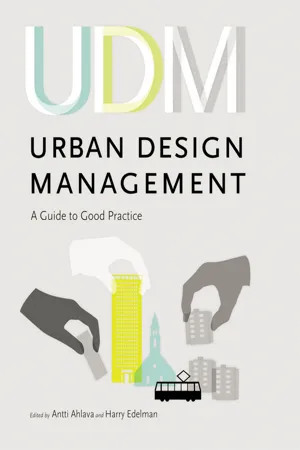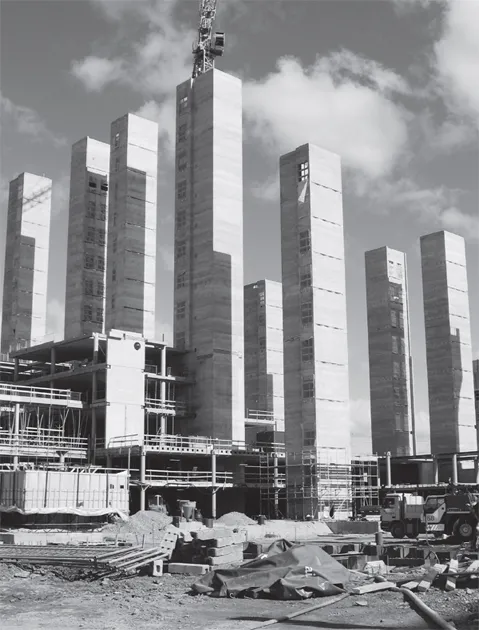![]()
1
The Perfect Match
| Leena Soudunsaari |
1.1 | Co-operation between national, regional and local levels |
| Harry Edelman |
1.2 | Integrative Development: principles and stakeholders |
| Tommi Mäkynen |
1.3 | Value to whom? Understanding the ‘client’ |
| Bibliography |
We shall begin this chapter by examining the hierarchical levels of planning processes. These levels make up the framework for decision-making in land-use projects. A planning system is based on the principle that decisions are first made on a larger scale and then specified in each individual case. We shall compare the Dutch and Finnish land-use systems. The official practices in question make up the framework for projects, which grow from the grass roots upwards; such projects are the subject of this book.
In practice it is often difficult to determine the exact starting point of a project that has been initiated outside the official channels. Similarly, the political activity that land-use planning is based on can begin without anyone noticing it. Even before the project, parties that sense the possibility of change can start to prepare for it, looking ahead to future projects and negotiations. Once the project is under way, it may be necessary to get together a sufficiently large project development group. Both in the preparations and at the beginning of a project, an essential element is how discussions are initiated.
This chapter deals with the make-up of a good project work group, and the significance of good negotiation skills. How should one prepare oneself for negotiations? How are the interests of other parties to be identified? What is the significance of expertise in projects? And who in fact are the experts and the clients? The principles of Integrative Development may help to provide answers to these questions.
1.1
Co-operation between national, regional and local levels
Leena Soudunsaari
The main principles of land-use planning systems are similar in the Netherlands and in Finland, distributing responsibility between national, regional and local levels. Consequently, the group of actors involved in urban design and planning also has a similar make-up. There are, nevertheless, differences in emphasis concerning the influencing/deciding party (Newman and Thornley 1996). In the Netherlands the starting point is systematic planning, and in this the national level exerts influence. In Finland the role of national planning is less important and the emphasis is on the influence exerted at the local level.
The working of the Dutch system is often described by two concepts: horizontal co-ordination and vertical co-ordination. The former describes co-operation ‘inside’ the national level (for example between different ministries) and the latter co-operation with other administrative parties (national, regional and municipal co-operation) (Faludi 2000).
1.01 Building Salmisaari, Helsinki. Photo TM.
Table 1.02: The system and instruments of land-use planning in the Netherlands.
Level of planning | Organization | Instruments |
National level | VROM | the National Strategy (Nota Ruimte) |
| Rijksplanologische Dienst | the National Spatial Planning Commission (structuurschema, structuurschets) |
| Rijksplanologische Commissie | the Projects of National Importance (concrete beleidsbelissing) |
Regional level | Provincie | Provincial Government Regional Plan (streekplan) prepares, approves, optional |
Local level | Gemeente | Municipality Master Plan, Joint Master Plan (structuurplan) prepares, approved by the province, optional Detailed Plan (bestemmingsplan) prepares, approved by the province, statutory |
Table 1.03: The system and instruments of land-use planning in Finland.
Level of planning | Organization | Instruments |
National level | Council of State | National Land-Use Guidelines as guidelines |
Regional level | Regional Council | Regional Councils Regional Plan (maakuntakaava) prepares, approves, ratifed by the Ministry of the Environment, statutory |
Local level | Municipality | Municipality Joint Master Plan (kuntien yhteinen yleiskaava) prepares, approved by the joint body of the municipalities, ratifed by the Ministry of the Environment, optional Master Plan (yleiskaava) prepares, approves, statutory Detailed Plan (asemakaava) prepares, approves, statutory |
About every ten years, the Dutch government draws up a national land-use strategy together with the Ministry of Housing and Environment (Ministerie van Volks-huisvesting, Ruimtelijke Ordening en Milieubeheer, VROM). The objectives of the strategy are revised on the basis of results from earlier programmes. In addition to programmes that direct community structure, national architectural policy programmes, which are drawn up every four years, also influence spatial and land-use planning. The implementation of the programmes is closely linked to nationally important development projects, which are taken into account in planning at the local level (Visser 2006).
At the regional level, the implementation of national land-use objectives is directed by the Provincie and its organizations; the provincial government also approves voluntary regional plans called streekplan as well as legally binding detailed plans, bestemmingsplan, which are drawn up by the municipalities. In addition to the detailed plans, municipalities can draw up voluntary joint master plans (approved by the Provincie) and voluntary master plans, structuurplan, which are used to co-ordinate the development of the municipality. A bestemmingsplan may include large or small plans, depending on the location of the land area (European Union 1999).
In the Netherlands, the process of project development usually starts in cooperation with consultants who are specialized in land-use planning and spatial planning. Planning is thus the result of co-operation between the consultant and the municipality; however, the municipality usually has the leading role (Straver-Nevalainen 2006).
The Finnish system is strongly vertical; Regional Environment Centres and municipalities play an important role in the planning and direction of land use.
It is the duty of the Ministry of the Environment to deal with general development and to produce guidelines for regional land-use planning and building. At the provincial level the Ministry promotes, directs and supervises land-use planning. A Regional Environment Centre promotes and sets out guidelines for the organizing of spatial planning and building within the municipalities. This Centre is mainly responsible for giving guidance and expert help to the municipalities (development negotiation, negotiation between authorities).
It is the job of the municipality to deal with the specifics of land-use planning, along with the direction and control of building, and to give guidance in permit issues. Indeed, the municipalities take on the overall responsibility for building (Ekroos and Majamaa 2000).
In addition to the national land-use guidelines, the land-use planning system includes a regional plan, a master plan and a detailed plan. The regional plan is drawn up and approved by the Regional Council, and confirmed by the Ministry of the Environment. The master plan is drawn up and approved by the municipality. Municipalities can also draw up a joint master plan, which is confirmed by a joint body of the municipalities. A joint master plan of the municipalities is confirmed by the Ministry of the Environment. The detailed plan is drawn up and approved by the individual municipality concerned (www.finlex.fi).
1.2
Integrative Development: principles and stakeholders
Harry Edelman
The parties in urban design and real estate development include various municipal units, investors, builders, users and all representable actors who are affected by the plans or actions. In Integrative Development the starting point for negotiations is the consideration of all viewpoints. A prerequisite for negotiations is the identification of those interest groups that have a mandate to represent a certain group and its interests. In Integrative Development the initiating party (or parties) actively works to identify the appropriate parties and to prepare for the negotiations. The preparation requires knowledge of integrative negotiation practice and the ability to use it in urban design and real estate development.
The principles of integrative negotiation have evolved from negotiation practices independently of any philosophy or theory. In the 1960s Richard Walton and Robert McKersie advanced integrative negotiation theory within the framework of trade union negotiations in the United States. These principles were used in negotiations on the production of the built environment in the United States during the 1970s (mainly following the development of EIA legislation) in attempts to solve disputes about environmental conservation.
Mary Parker Follett has provided an example illustrating the principle of integrative action. Two sisters are bickering over an orange that both need for baking. The quarrel ends with the orange being split, although one of the sisters would have needed the juice and the other the peel. The sisters could not find a solution that satisfied the interests of both. A compromise does not add to value but distributes existing value. Integrative action adds, wraps up and distributes value in a way that enables the different parties to identify solutions that are important to them.
The problem in negotiations concerning urban design and real estate development is often that people stick to conventional positions and solutions – as in how to split an orange. In negotiations on the production of the built environment there are many more variables than there are in dividing an orange, yet also possibilities for creative solutions that can satisfy the interests of the parties. Indeed, the issues in negotiation should be seen in an innovative way: as possibilities and not just as difficult problems – still less as a crowd of difficult people with whom negotiation is impossible.
Another frequent problem is that negotiation issues are personified...


